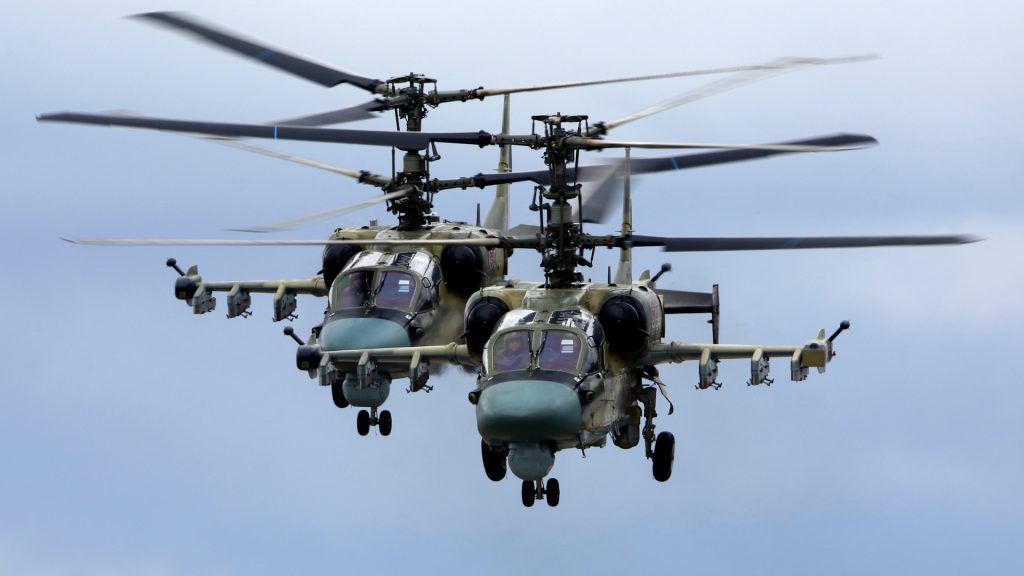Russia’s Ka-52 Alligator helicopters have proven to be formidable assets in contested airspace, showcasing their capabilities and effectiveness in the ongoing conflict in Ukraine. Despite initial setbacks and heavy losses, these attack helicopters have persistently demonstrated their prowess on the battlefield.
According to a recent statement from the United Kingdom Ministry of Defence, Russia has gained a temporary advantage in southern Ukraine, particularly with the deployment of attack helicopters armed with longer-range missiles against ground targets. This advantage has allowed Russian forces to slow Ukrainian movements and inflict damage or destruction on Western-provided tanks and armored fighting vehicles. The UK Ministry of Defence acknowledges the impact of Russia’s attack helicopters, highlighting their temporary advantage in the region.
The Ka-52 Alligator helicopters have managed to slip past air defenses, enabling them to carry out successful operations against enemy targets. A recent New York Times article reported that these helicopters have hindered Ukrainian movements while causing significant damage to Western-provided tanks and armored fighting vehicles. Their ability to penetrate enemy defenses has proven to be a strategic asset for the Russian forces.
Among the Russian Air Force’s attack helicopters, the Ka-52 is one of the most widely used. Its combat effectiveness has been proven time and again. In a notable incident on June 19, despite sustaining severe damage to its tail assembly and cockpit section, a Ka-52 helicopter managed to safely return to base and land. This incident showcased the helicopter’s resilience and the skill of its crew.
The Ka-52 is armed with the Vikhr-1 guided air-launched missile, which is specifically designed to engage moving ground targets protected by reactive armor. With a weight of 59 kg, a target engagement range of up to 8,000 meters, and an armor-piercing capability of 750 mm, the Vikhr-1 missile provides the Ka-52 with a potent offensive capability against a variety of targets, including ground, water surface, and air targets.
The successful use of Russian combat helicopters in real combat scenarios has generated a surge in international demand for these advanced aircraft. Russia’s Federal Service for Military-Technical Cooperation highlighted the high efficiency and reliability of Russian weapons, including fighter jets, attack helicopters, armored vehicles, and multiple launch rocket systems. The combat performance of these weapons has led to increased interest from foreign countries seeking to enhance their military capabilities.
To reinforce its attack helicopter forces, Russia has deployed additional helicopters to Berdyansk Airport, which is approximately 100 kilometers behind the front line in Ukraine. With a force of 133 Ka-52 helicopters as of 2022, Russia has established a significant presence in the region, demonstrating its commitment to employing these advanced aircraft to gain an advantage in the conflict.
The Ka-52 is renowned for its unique coaxial rotor design and side-by-side crew seating arrangement. It has been involved in the thickest fighting more than any other Russian attack helicopter since the conflict began in February 2022. Introduced into service in 2011, the Ka-52 is one of Russia’s most modern helicopters, equipped with ejection seats for its pilots, a feature rarely found in helicopters. Its impressive specifications include a ceiling of 18,000 feet and a top speed of 186 mph. The helicopter’s armament includes rockets, missiles, and a 30 mm autocannon, with some variants featuring a nose-mounted forward-looking infrared camera for enhanced targeting capabilities.
The Ka-52 Alligator helicopters have proven their mettle in contested airspace, showcasing their combat effectiveness and contributing to Russia’s temporary advantage in the conflict in Ukraine. With their advanced features, firepower, and ability to penetrate enemy defenses, these helicopters have become a sought-after asset in the international defense market. As the conflict continues, the Ka-52’s presence and impact are likely to remain significant, shaping the dynamics of the battlefield and the outcome of the conflict.
The Ka-52 Alligator’s success in contested airspace can be attributed to a combination of factors. Its advanced avionics and targeting systems provide excellent situational awareness to the crew, enabling them to accurately engage ground and air targets. The helicopter’s coaxial rotor design enhances maneuverability, allowing it to operate effectively even in challenging environments. The side-by-side seating arrangement promotes effective communication and coordination between the pilot and gunner, enhancing the overall effectiveness of the helicopter in combat situations.
Furthermore, the Ka-52’s impressive armament gives it a significant offensive capability. With the ability to carry up to 4,000 pounds of rockets, missiles, and a 30 mm autocannon, it can engage a wide range of targets effectively. The nose-mounted forward-looking infrared camera on certain variants enhances target acquisition and tracking, enabling precise and efficient engagement of enemy forces. These features make the Ka-52 a versatile platform that can adapt to various mission requirements on the battlefield.
The success of the Ka-52 Alligator helicopters in Ukraine has also served as a testament to the efficiency and reliability of Russian military technology. Their versatility, firepower, and ability to operate in contested airspace make them a formidable asset. With their advanced capabilities, including longer-range missiles, the ability to slip past air defenses, and their role in slowing enemy movements and damaging armored vehicles, these helicopters have provided Russia with a temporary advantage. The combat performance of these helicopters has garnered international attention, leading to increased interest from foreign militaries. The surge in demand for Russian weapons, including fighter jets, attack helicopters, armored vehicles, and multiple launch rocket systems, highlights the trust and confidence placed in the capabilities of Russian military hardware.
